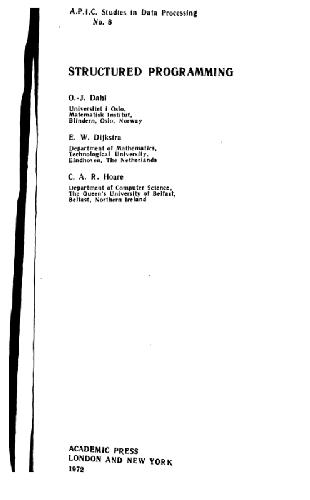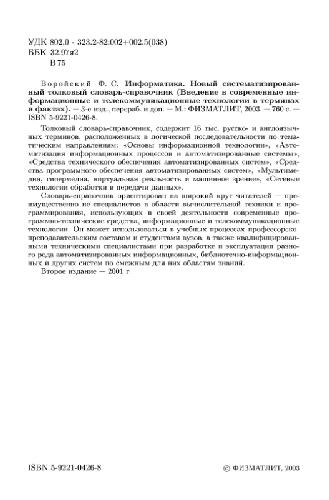Isabel Evans158053662X, 9781580536622, 9781580536639
Table of contents :
Achieving Software Quality Through Teamwork……Page 1
Contents……Page 8
Forward……Page 16
Preface……Page 18
Acknowledgments……Page 24
1.1 Defining software quality……Page 26
1.2 Fundamental concepts of excellence……Page 30
1.3.1 Enablers……Page 32
1.3.2 Results……Page 34
1.4 ISO 9000:1994 and ISO 9000:2000……Page 35
1.5 IT maturity models-CMM and relations……Page 36
1.6 Team Software Process and Personal Software Process……Page 37
1.7 Bringing the models together……Page 38
References……Page 40
Selected bibliography……Page 41
2.1 Teams in disunity……Page 42
2.2 Defining the team……Page 44
2.2.2 People who manage software projects……Page 45
2.2.4 People who measure software quality……Page 46
2.3.1 Differences in quality viewpoints……Page 47
2.3.2 Intergroup relationships in CMM? and Personal and Team Software Processes……Page 49
2.3.3 Intergroup relationships and excellence frameworks-the EFQM Excellence Model……Page 50
Selected bibliography……Page 53
3.1 Introducing the customers……Page 56
3.2 Who could be in this group?……Page 57
3.2.1 In-house customer……Page 58
3.2.2 Third-party custom-made system customer……Page 60
3.2.3 Third-party package or commercial off-the-shelf (COTS) customer……Page 61
3.3 Quality viewpoint……Page 63
3.4.1 The EFQM Excellence Model and the customer organization……Page 64
3.4.2 EFQM Excellence Model enablers for customers……Page 65
3.4.3 EFQM Excellence Model results for the customers……Page 68
3.5 Communication between the customers and other groups……Page 70
3.6 Summary of the group……Page 72
Selected bibliography……Page 74
4.1 Introducing the managers……Page 76
4.2 Who could be in this group?……Page 77
4.3 Quality viewpoint……Page 78
4.4.1 The EFQM Excellence Model and the manager……Page 79
4.4.2 EFQM Excellence Model enablers for the managers……Page 82
4.4.3 EFQM Excellence Model results for the managers……Page 90
4.5.1 Managers and communication cycles……Page 93
4.5.2 The reporting process……Page 95
4.6 Summary of the group……Page 98
References……Page 99
Selected bibliography……Page 100
5.1 Introducing the builders……Page 102
5.2 Who could be in this group?……Page 104
5.3 Quality viewpoint……Page 105
5.4.1 The EFQM Excellence Model and the builders……Page 111
5.4.2 EFQM Excellence Model enablers for builders……Page 112
5.4.3 EFQM Excellence Model results for the builders……Page 117
5.5 Communication between the builders and other groups……Page 120
5.6 Summary of the group……Page 121
References……Page 122
Selected bibliography……Page 123
6.1.1 Why do we need QA and QC?……Page 126
6.1.2 Just measurers or also improvers of quality?……Page 127
6.1.3 Defect prevention……Page 128
6.1.4 The Hawthorne effect……Page 130
6.3 Quality viewpoint……Page 131
6.4.1 The EFQM Excellence Model and the measurers……Page 138
6.4.2 EFQM Excellence Model enablers for the measurers……Page 139
6.4.3 EFQM Excellence Model results for the measurers……Page 148
6.5 Communication between the measurers and other groups……Page 150
6.6 Summary of the group……Page 153
Selected bibliography……Page 154
7.1 Introducing the supporters……Page 156
7.2 Who could be in this group?……Page 158
7.3 Quality viewpoint……Page 159
7.4.1 The EFQM Excellence Model and the supporter……Page 161
7.4.2 Enablers for the supporters……Page 163
7.4.3 Results for the supporters……Page 168
7.5 Communication between supporters and other groups……Page 171
7.6 Summary of the group……Page 172
7.7 Summary of all the groups……Page 173
References……Page 175
Selected bibliography……Page 176
8.1 Life span or life cycle?……Page 178
8.1.2 Development……Page 180
8.1.4 Postdelivery……Page 181
8.2 Entry and exit criteria between stages……Page 182
8.3 Changes in quality viewpoints across the life span of a system……Page 183
References……Page 184
9.1 Start-up-description……Page 186
9.2 Start-up viewpoints……Page 188
9.3 Entry criteria for start-up……Page 189
9.4.1 Understanding the problem/idea……Page 190
9.4.2 Decide whether the problem/idea is worth solving……Page 193
9.4.4 Agree on next stage……Page 195
9.4.5 Contract for work……Page 196
9.5 Exit from start-up stage……Page 203
References……Page 204
Selected bibliography……Page 205
10.1 Software-development life cycle-description……Page 206
10.1.1 Types of software acquisition project……Page 207
10.1.3 SDLC task summary……Page 208
10.2 SDLC viewpoints……Page 209
10.3.1 Entry criteria following a detailed start-up……Page 211
10.3.3 When entry criteria have not been met……Page 212
10.3.4 Tailoring entry criteria……Page 214
10.4.1 Planning and monitoring……Page 215
10.4.2 Managing change……Page 216
10.4.3 Requirements……Page 217
10.4.5 Build……Page 218
10.4.6 Testing……Page 219
10.6 SDLC models……Page 220
10.6.1 Waterfall model (big bang or phased)……Page 221
10.6.2 Spiral, incremental, and iterative models……Page 224
10.6.4 V-model……Page 228
10.7 Quality views and the models-why we might wish to combine models……Page 229
10.8.1 Exit criteria following a detailed acceptance test……Page 233
10.8.2 When no exit criteria have been defined……Page 234
10.8.5 When no acceptance criteria have been set……Page 235
10.9 Conclusion……Page 236
References……Page 237
Selected bibliography……Page 238
11.1.1 Delivery considerations……Page 240
11.1.2 Identifying the delivery……Page 242
11.2 Delivery viewpoints……Page 243
11.4 Delivery-typical activities……Page 246
11.4.1 Person buys PC and software for self-installation……Page 248
11.4.3 Multisite rollout of new software to existing infrastructure……Page 249
11.4.4 Data migration project software and hardware changes……Page 250
11.6 Conclusion……Page 251
Selected bibliography……Page 252
12.1 Postdelivery-description……Page 254
12.1.1 Postdelivery for different types of software acquisitions……Page 255
12.2 Delivery viewpoints……Page 256
12.4.1 Use of the system……Page 258
12.4.2 IT infrastructure and service management activities……Page 259
12.4.3 Making changes to an existing system……Page 261
12.4.4 Monitoring and evaluation……Page 266
12.6 Conclusion……Page 269
References……Page 271
Selected bibliography……Page 272
A.1 Communication, team dynamics, and meeting behavior……Page 274
A.1.1 Belbin Team Roles……Page 275
A.1.2 De Bono’s Six Thinking Hats……Page 276
A.2.1 Myers-Briggs Type Indicators……Page 278
A.2.2 Honey and Mumford Learning Styles……Page 279
A.2.3 Kirton adaptors and innovators……Page 280
A.2.4 Motivation studies……Page 281
A.2.5 Transactional analysis……Page 282
A.3.1 Cause–effect, root cause, and solution analysis……Page 284
A.3.2 Prototyping and ideas modeling……Page 286
A.3.3 Assessing whether an idea is worth pursuing……Page 287
A.4 Understanding aims and objectives……Page 290
A.5 Review techniques……Page 291
A.6 Improving graphics in reporting……Page 292
A.7 Useful sources and groups……Page 294
References……Page 295
Selected bibliography……Page 297
B.1 The document family……Page 298
B.2 Why we use document templates……Page 300
B.5 The team’s information needs……Page 303
B.8 Do you need a document at all?……Page 304
B.9 Simple project audit plan and report templates……Page 305
References……Page 307
About the Author……Page 308
Index……Page 310







Reviews
There are no reviews yet.